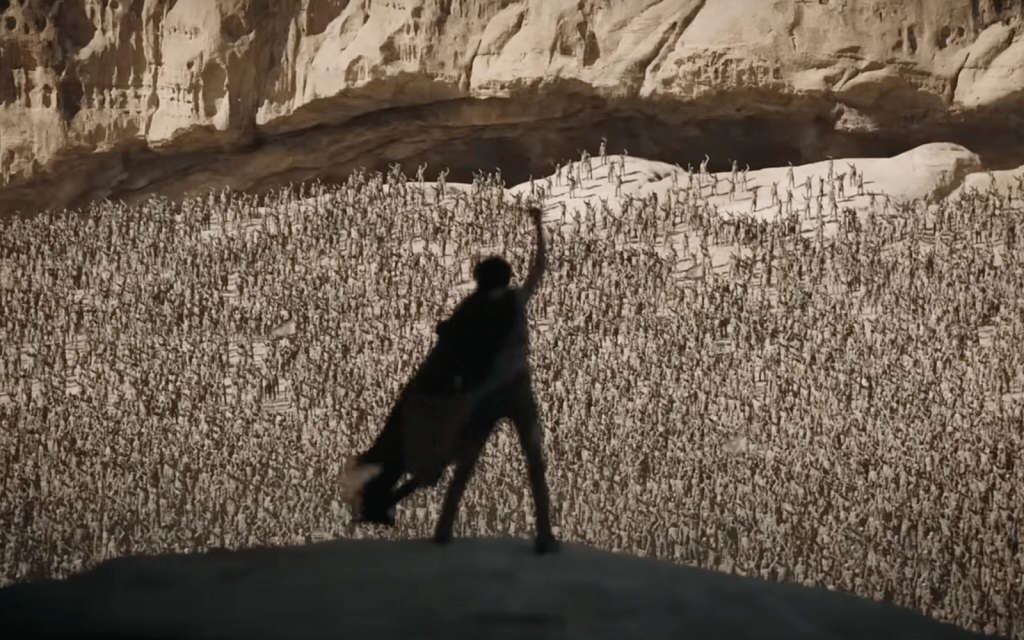The second instalment of Denis Villeneuve’s Dune has dominated most conversations about cinema in the first few months of 2024. Adapted from Frank Herbert’s classic novel, the two-part epic has been credited with reviving the science fiction genre, and the blockbuster experience in general.
Villeneuve’s latest movie, however, is not just a mere sci-fi blockbuster. Although Dune features many familiar sci-fi visual trappings – interstellar travel, atomic arsenals and distant planets inhabited by alien lifeforms – its main strength resides in telling a fantasy story outside the traditional confines of this genre.
After all, Dune is the story of an aristocratic hero who, after undergoing a series of religious trials, acquires supernatural powers that allow him to overthrow the leader of a feudal empire. Similarly, Dune’s dukes, barons and princesses engage in arcane traditions and ritualised sword fighting. Villeneuve’s films are clearly new classics of epic fantasy cinema.
Epic – or high–fantasy is a sub-genre defined by an emphasis on large narrative scale (in both geographic and temporal terms), detailed fantastical universes, and a mythical hero. Usually some kind of “chosen one”, this hero embarks on a journey full of magic, monsters and other creatures.
In epic fantasy films, there is usually a clear opposition between good and evil, with the destiny of the imaginary universe within which the story takes place at stake.
The sweeping scope of epic fantasy cinema can also translate into gargantuan running times, while the spectacular foregrounding of imaginary worlds and creatures requires large budgets, extensive production infrastructures and advanced technology.
The origins of epic fantasy cinema
In recent times, the epic fantasy label has been assigned to films and TV series such as Star Wars, Excalibur, The Lord of the Rings, Game of Thrones and the Avatar franchise. But its origins can be traced back a century, to 1924, when Fritz Lang’s Die Nibelungen premiered at Berlin’s Ufa Palast am Zoo theatre.
Die Nibelungen is a two-part film based on the German medieval epic poem The Nibelungenlied. The first movie, Siegfried, and the second, Kriemhild’s Revenge, were released two months apart between February and April 1924. Together, the two films reach a total running time of nearly five hours and are considered major landmarks of German film history.
Despite the social and economic crisis that followed Germany’s defeat in World War I, the German film industry in the 1920s was thriving, as audiences sought to escape the grim reality of the post-war period. Many of the German films of this era – including The Cabinet of Dr Caligari, The Golem, and Nosferatu – explored the theme of identity and reality through the lens of fantasy and horror.
Similarly, Lang and his wife, screenwriter Thea von Harbou, felt the fantastic Nibelungen saga, which had been popularised by Wagner’s operatic adaptation in the 19th century, would resonate with the defeated people of Weimar Germany. By adapting one of the most powerful icons of German culture, Lang and von Harbou aimed to embolden the nation and foster national pride.
Die Nibelungen opens with a title dedicating the film to the German people. Shortly after, we are introduced to Siegfried, a forest-dwelling blacksmith. Upon hearing stories of the virtuous princess Kriemhild, the sister of King Gunther, he decides to win her heart.
Siegfried embarks on an epic journey during which he kills both a dragon and a dwarf king, thus gaining treasure and a cloak of invisibility. In return for permission to marry Kriemhild, he agrees to use the cloak to help Gunther win the fierce warrior-queen Brunhild by trickery.
The two couples are married, but when Brunhild discovers the deception, she compels Gunther and his evil vassal Hagen into a conspiracy to murder Siegfried. In the second film, Kriemhild vows to avenge Siegfried’s murder by killing Hagen, who is protected by Gunther.
In order to fulfil her plans, Kriemhild marries Etzel, king of the Huns, and persuades him to attack Hagen. The film ends with a brutal battle during which Hagen, Kriemhild and all her family are massacred.
A spectacle to rival Hollywood
Lang conceived Die Nibelungen as a production to rival Hollywood in scale and ambition. And the making of the two films was as epic as the story itself. Production lasted more than nine months and featured complex special effects, innovative lighting techniques, lavish costumes and massive sets.
The spectacular scene in which Siegfried slays the 16-metre dragon was a true standout for its time, and was considered an impressive feat of film puppetry. The success of Die Nibelungen paved the way to another large-scale German production, 1927’s Metropolis, which would become Lang and von Harbou’s best-known work.
The innovative use of film technology and special effects, so crucial to the success of Die Nibelungen, remains an essential feature of contemporary epic fantasy cinema. In the 21st century, the technical achievements of epic fantasy films such as The Lord of the Rings, Avatar and Dune are still central to their marketing.
However, the similarities between Die Nibelungen and contemporary fantasy epics are not confined to the narrative, aesthetic and technological dimensions.
Despite the fact that Lang held antifascist beliefs and fled Germany shortly after the rise of Hitler, Die Nibelungen was systematically used as a propaganda tool by the Third Reich, which admired the film’s celebration of both nationalist sentiments and a heroic Űbermensch.
The movie’s association with the Nazi regime has remained an ideological stain on epic fantasy cinema that critics have often been quick to highlight. In the 1980s, Excalibur was attacked for supposedly advancing a fascist aesthetic, while an early review of The Fellowship of the Ring stated:
You can’t help feeling Hitler would have adored this film – with its hideous Untermenschen, its hobbits and its Aryan beauties.
Dune: Part Two spoiler-free review – The Muad’Dib of adapted film sequels
Similarly, Dune has been criticised for both its “white saviour” narrative tropes and its celebration of a messianic, autocratic figure.
Is epic fantasy’s escape into archaic worlds intrinsically conservative? Maybe. Or perhaps it’s up to viewers to take what they want from these fantastical adventures. As J.R.R. Tolkien said of the function of fantasy:
The authoritarians have us all in prison. If we value the freedom of mind and soul, if we’re partisans of liberty, then it’s our plain duty to escape.
If that’s the case, thank God for epic fantasy movies and their ability to help us make that escape.
- is an Associate Professor, School of English, Film, Theatre, Media and Communication, and Art History, Te Herenga Waka — Victoria University of Wellington
- This article first appeared in The Conversation




